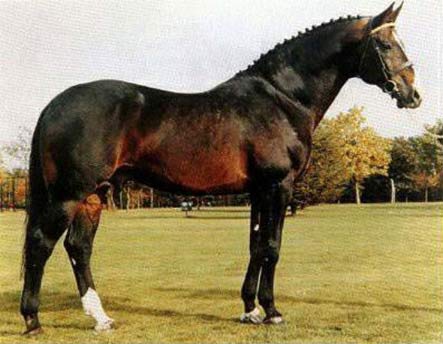 |
|
In a lifespan of thirty years, the "preferent" G Ramiro Z's performance as a sporthorse and breeding sire earned him the titles 'Stallion of the Century' and "King of Sires." His progeny can be described with one word: sublime. He supplied a large number of stallions approved in the Netherlands and abroad as well as an impressive series of fantastic sport horses many of whom have achieved fame. His daughter, the super-mare Ratina Z, is the dream of the show jumping world, winning double Olympic gold medals (1992 and 1996) at the Barcelona Olympics, and the World Cup of 1993. Ramiro's progeny distinguish themselves in dressage as well. Despite his impressive ancestry and sports results, one of G Ramiro Z's biggest claims to fame are his fertility and sperm quality. They were so high that he was used in the research of artificial insemination and frozen semen to produce the science we know today. This fertility is passed on to his offspring, including ROYAAL Z. Ramiro still ranks number 16 on the 2003 World Breeding Federation jumping stallion rankings. He is arguably the most influential jumping stallion ever...
Background on Ramiro Z Ramiro was the most popular distributor of the Ramzes blood and the most frequented sire in Germany. He stood at stud in Westfalia, Holstein, Zangersheide and Holland. Numerous sons and daughters conserve and pass on the valuable genes that stand for rideability and jumping talent. Therefore, it is not a surprise to find Ramiro's children and grandchildren at the top levels of showjumping and dressage. It is simply impossible to mention all his successful progeny. From his first breeding season, came the super mare, Fatinitza, show jumping from victory to victory under Fritz Ligges and Thomas Frühmann, and later mother of the Zangersheide stallion, Almiro Z. Ramiro's second season saw him in Holstein where he produced three stallions: Rinaldo (out of a Trakehner mare), Rio Negro, who became a Grand Prix dressage horse, trained by Willi Schultheis, and Ronald, who was for years the most popular stallion in Holstein, where he sired five licensed sons and more than a hundred top broodmares, many of whom became mothers of sires like Alcatraz, Libero, Lord Incipit, Larno, Le Grand - all exquisite sires and sporthorses. Ronald, like his famous father, went to Holland - where he stood for five years, and sired, among others, the show jumping sire Saluut, the father of the Australian stallion, Salute. Ramiro's influence on the Dutch Warmblood breeding was, and still is, of utmost importance. The Dutch bestowed the title 'Horse of the Year' on Ramiro in 1992. For Leon Melchior's performance breeding program at Zangersheide, Ramiro became the strongest and most successful pillar. Ramiro was one of the first stallions to appear in the sport. During his own sporting career, he had numerous wins at all levels of show jumping - Nations Cups, Puissance (jumping over 2.2 metre!) and in international Grand Prix competition. When Ramiro was presented for selection, he was described as the ideal type of the modern Holsteiner - strongly imprinted by his dam, tall and elegant, showing the top line of his grandfather, Cottage Son xx, with powerful frame, a glorious face and large, clear eyes. His excellently formed neck, beautifully set, could still be seen, even when he was an old horse, and are stamped on his progeny. Ramiro displayed a very good walk, a normal trot, and a great canter - it was impossible not to be enthusiastic. Based at the Zangersheide Stud of Leon Melchior, Ramiro was presented with a selection of superbly bred jumping mares. His most famous 'nick' was with the foundation mare, Heureka. The oldest daughter of this pairing was RATINA Z who ridden by Piet Raymakers and Ludger Beerbaum, won World Cup Finals, the European Championships, the Grand Prix of Aachen, individual Olympic Silver, double Olympic Team Gold, Team Gold at the WEG, and twice team gold at the European championships. Argentina Z another Heureka daughter (by Almé) produced with Ramiro the stallion sons: Rebel I Z, Rebel II Z, Rebel III Z and Rock Z. Text in part from The Horse Magazine Online | ||||